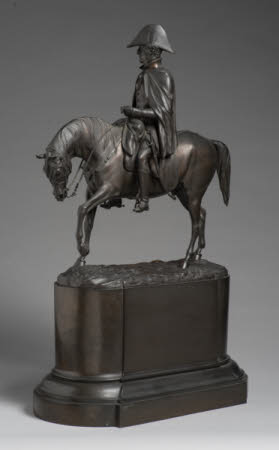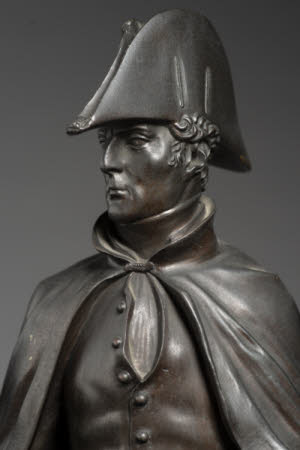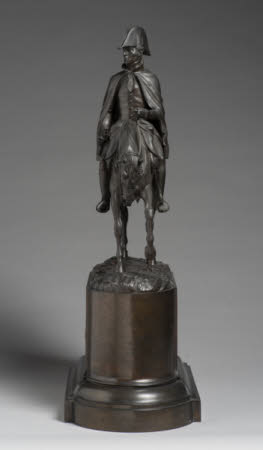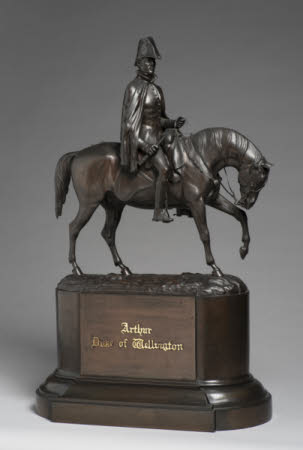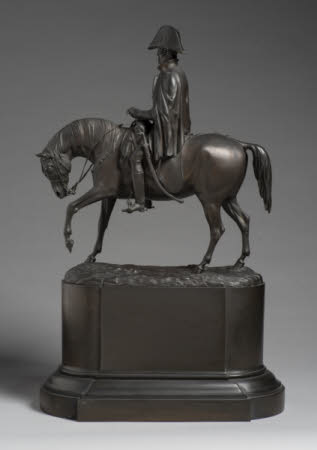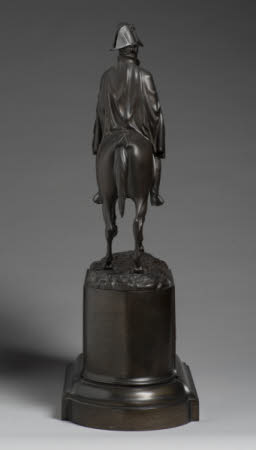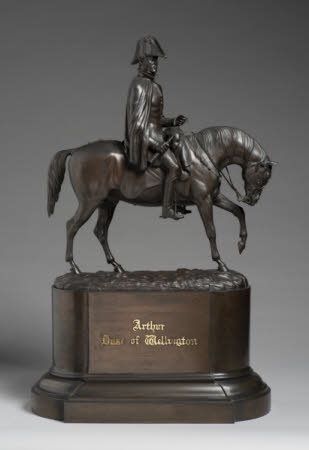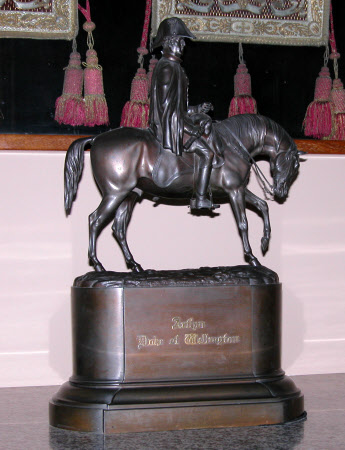Arthur Wellesley, 1st Duke of Wellington (1769-1852) on horseback at Waterloo
Edmund Mingay Cotterill (1794 - 1860)
Category
Art / Sculpture
Date
c. 1837 - 1840
Materials
Bronze
Measurements
64 x 39 cm
Place of origin
London
Order this imageCollection
Ickworth, Suffolk
NT 850846
Summary
Sculpture, bronze; The Duke of Wellington on horseback; Edmund Cotterill (1795-1860); Garrard’s, London; c. 1837. A statuette celebrating Arthur Wellesley, 1st Duke of Wellington (1769-1852), whose army career made him the greatest British military hero of the 19th century, but who also subsequently played a distinguished role in public life as politician and Prime Minister. The statuette, which shows the Duke as a commander at the height of his career during the Battle of Waterloo, and mounted on his favourite horse, Copenhagen, was first made in 1837 in a silver version ordered by the Duke for his London home, Apsley House. It sat on a sideboard in the main 'Waterloo' Gallery, being brought onto the main table for the dinners held each year in commemoration of the battle. Further versions of the statuette in both silver and bronze were made in some numbers in the years from 1837. Its designer was Edmund Cotterill, head of design with the London gold- and silversmiths R & S Garrard. Cotterill created for Garrard numerous highly sculptural centrepieces and trophies from the mid-1830s to his death in 1860, ensuring the firm became known as the leading purveyor of these large ensembles, among the most characteristic products of the London silver trade during the early decades of the reign of Queen Victoria.
Full description
An equestrian statue of Arthur Wellesley, 1st Duke of Wellington (1769-1852) in field marshal’s uniform and cloak and wearing his bicorne hat, mounted on his favourite mount Copenhagen, who paws the ground. The Duke holds a telescope in his right hand and looks to his right. Mounted on a large bronze plinth, naturalistically modelled beneath the horse and rider, and with the name of the subject in brass letters on one side. The bit, reins and stirrups are separately made. The 1st Duke of Wellington is still today a very well-known historical figure, famous for his leading part in the victory over Napoleon at the Battle of Waterloo on 18th June 1815. For decades after Waterloo Arthur Wellesley was almost universally regarded, in Britain and well beyond, as the greatest man in the world. He became the subject of innumerable portraits, from the grandest paintings and sculptures to popular keepsakes and utensils. Arthur Wesley, as he was known early in his life, was born in 1769 in Dublin, the son of the Earl and Countess of Mornington, Anglo-Irish landowners whose seat was in County Meath in Ireland. His father Garret Mornington was very musical and became the first Professor of Music at Trinity College, Dublin. At an early age Wellesley decided to make the army his career. He was commissioned as an ensign in 1787, in the 1790s serving first in the Netherlands and later in India, where his skills of leadership were fully demonstrated at the Battle of Assaye in 1803, which saw the defeat of the forces of the Maratha Confederacy. His fame grew rapidly though during the outstanding leadership of his forces during the Peninsular war of 1808-13 in Portugal and Spain, which culminated in the Battle of Vittoria in 1813 and the final driving of French forces from out of the Iberian peninsula. Wellesley was created Duke of Wellington and in 1814was sent to Paris as British Ambassador, before in 1815 being forced to return to the battlefield for the 100 Days Campaign, which culminated in the final defeat of Napoleon at Waterloo by the British under Wellington and Field Marshal Blucher’s Prussian troops. Following Waterloo, Wellington finally retired from the army, famously saying: “I hope to God that I have fought my last battle. It is a bad thing to be always fighting.” He nevertheless remained Commander-in-Chief of the Forces until his death in 1852. He then returned to politics, serving as Prime Minister between 1828-30 and again very briefly in 1834. Wellington was not though popular in this role, twice being assailed by rioters. He was forced to protect the ground floor windows of Apsley House by installing iron bars, earning his nickname of the ‘Iron Duke’. Wellington did take one major achievement away from his first term as Prime Minister, the passing of the Act for Catholic emancipation in 1829. As he grew into the role of elder statesman, Wellington continued to be a leading figure in the House of Lords until his final retirement in 1846. He was throughout his career generally associated with more conservative political positions that aimed at preservation of the status quo. Apart from the scale of his achievements, the personality of Wellington helps to explain why almost every contemporary painter and sculptor of note sought to portray him. The Romantic era, which reached its height in the first decades of the nineteenth century, worshipped heroism as manifested in the individual. Not only his extraordinary military triumphs but also Wellington’s strongly-chiselled features and slightly remote personality chimed strongly with the notion of the Romantic hero. The Ickworth equestrian figure of the Duke of Wellington shows him as Field Marshal and as if commanding his troops during his greatest achievement as military leader, at the Battle of Waterloo, looking keenly to his right, his telescope in his hand, mounted on his favourite horse Copenhagen. The original model was designed as a silver centrepiece for Wellington's London residence, Apsley House, where it was displayed on a sideboard in the Waterloo Gallery, and may be seen in a watercolour from c. 1852, on the main table as prepared for the annual Waterloo Banquet (London, Victoria and Albert Museum, Inv. WM.1-1981). The statuette was made by the jeweller and silversmithing company R. & S. Garrard and designed by Edmund Cotterill 1795-1860), whose signature may be seen on the textured part of the base, along with an inscription recording the 'publication', i.e. issuing for public sale, of the Wellington statuette on 18th June 1837. Cotterill, since 1833 at the head of Garrard’s design studio, did much to establish the reputation of the company for the production of elaborate sculptural groups and centrepieces in bronze and silver, with Equestrian, Moorish or Arab themes. He attended the Royal Academy Schools in 1820 and exhibited at the Academy, 1822-1858. According to the Illustrated London News, Cotterill stood 'at the head of the class of artists who model for silversmiths and his productions, annually exhibited at Messrs Garrard, have earned that house a celebrity which no other can equal' (ILN, 11 June 1842, p. 73). The ILN frequently discussed and reproduced the latest silver centrepieces, statuettes and groups, many of them designed by Cotterill, which as a genre became among the most distinctive products of silversmiths working in the Victorian age. Edmund Cotterill’s masterpieces for Garrards include the eight-feet high Eglinton Testimonial of 1842 (Gere and Culme 1993, pp. 8-9), a commemoration of the colossally expensive and much-ridiculed attempt to re-enact a Medieval jousting tournament, organized by the Earl of Eglinton in 1839. Cotterill also collaborated with Prince Albert in 1842 and 1853 on the design of two major centrepieces still in the Royal Collection, the first in 1842/43 in Renaissance style and featuring some of the Royal Family’s favourite dogs (Gere and Culme 1993, pp. 13-15; Marsden 2010, pp. 270-71, no. 185), the second the Alhambra Table Fountain made a decade later in 1853, the architecture of which is based on the famous Moorish palace in Granada (Gere and Culme 1993, pp. 21-22; Marsden 2010, pp. 280-81, no. 194). Cotterill’s model must have been very popular, since numerous versions survive, both in silver and in bronze. Most of these are on an identical high base, with the applied inscription in Gothic brass letters ‘Arthur Duke of Wellington’ on one side. It seems the statuette became almost a required ornament for aristocratic and grand families; there are identical bronze versions at Felbrigg (NT 1399463), Dumfries House (Inv. DH-89-2007) and at Weston Park (Inv. 107.0008), whilst a version from the Raglan collection was sold in 2014 (Christie’s, 23 May 2014, lot 78). Silver versions include one on a splendid highly elaborate base, sold by Veritas Auctions, Lisbon (9-10 December 2015, lot 605) and another sold in 2023 (Lawrence’s of Crewkerne, Summer Fine Arts Sales, 11 July 2023, lot 352). This example was made for presentation in 1839 by the Conservatives of West Somerset to one Joseph Ruscombe Poole. The gift reminds us that the June 1837 ‘publication’ date on casts of the model represents only a starting point for production and that casts continued to be made beyond then. In fact, Cotterill exhibited the bronze statuette of the Duke of Wellington at the Royal Academy summer exhibition in 1839 (no. 1311), when the group was specifically described as depicting the Duke 'as at Waterloo, on his celebrated charger Copenhagen. Another silver version dated 1839 was sold at Freeman’s Philadelphia in 2019 (19 June, lot 36). Yet another bronze version is in Glasgow Museums (Inv. S.1), whilst other bronze examples recently on the art market include: Christie’s, 17 Dec 2015, lot 4, without the high base; Christie’s, 25 Feb 1999, lot 77; Dominic Winter Auctions, Cirencester, 9 March 2023, lot 535, on small wooden base. In 1845 the dilettante and lover of Margaret, Countess of Blessington, Alfred, Count d’Orsay (1801-52) made an equestrian statuette that is so similar to Cotterill’s image that it effectively should qualify as a pirating of the other artist's work, although there is no evidence that contemporaries saw it this way. It was nevertheless widely said that d’Orsay had had help from the sculptor William Behnes for the Duke’s portrait and from T.H. Nicholson, a well-known illustrator of horses, for Copenhagen (Connely 1952, pp. 409-11). The original sculpture, which according to d’Orsay depicted the Duke as commander of forces during the Peninsular war, was made in 1845 in a very large (96 cms. high) silver-gilt version by Hunt and Roskill, still in the Wellington family collections, where it is paired with a companion statuette of Napoleon (Wellesley 2014, pp. 146-47, no. 2). It apparently made a strikingly positive impression on the aged Duke, d’Orsay himself boasting to one correspondent that ‘I have just made a statuette of the Duke of Wellington, which is causing a revolution here…. The Duke pretends it is the most beautiful thing he has ever seen, and the only one by which he wishes to be known, physically, to posterity; he comes here continually to admire himself.’ In another letter d’Orsay claimed that ‘They say it will be a fortune for me, as every regiment in the service will have one…’ Certainly, numerous bronze versions are known, all apparently dated 1848, including an example in 2011 (Bonham’s, 19 October 2011, lot 240), and another in 2024 (Cheffin’s, Cambridge, 27 June, lot 715). Jeremy Warren July 2025
Provenance
Part of the Bristol Collection. Acquired by the National Trust in 1956 under the auspices of the National Land Fund, later the National Heritage Memorial Fund.
Marks and inscriptions
Brass inscription on long side of base:: ARTHUR / DUKE OF WELLINGTON Stamped inscriptions on base:: COTTERELL. SCULPT. PUBLISHED AS THE ACT DIRECTS BY R. & S. GARRARD PANTON ST. LONDON 18TH JUNE 1837.
Makers and roles
Edmund Mingay Cotterill (1794 - 1860), sculptor
References
Connely, Willard,. Count d'Orsay, the dandy of dandies, 1952. Gere and Culme 1993: Charlotte Gere and John Culme, with William Summers, Garrard. The Crown Jeweller for 150 years, 1843-1993, London 1993 Marsden 2010: Jonathan Marsden, ed., Victoria & Albert: Art and Love, exh. cat. Queen’s Gallery, London 2010 Wellesley 2014: Charles Wellesley, Marquess of Douro, Wellington Portrayed, London 2014.
